The city of Ioannina, next to the lake Pamvotis, is the capital of Epirus, northwestern Greece. Lake Pamvotis lies at the centre of a 480 metre-high basin in a picturesque mountain setting, with the Kyra Frosyni Island in its middle and the sprawling city of Ioannina on its western shores.
 Natural beauty, historic and modern buildings come together at Ioannina, offering a vibrant and contemporary city comprising the most important commercial and cultural centre in Epirus and north-western Greece.
Natural beauty, historic and modern buildings come together at Ioannina, offering a vibrant and contemporary city comprising the most important commercial and cultural centre in Epirus and north-western Greece.
The Archaeological Museum of Ioannina exhibits finds from Epirus ranging from the Paleolithic period to Roman times. They include artefacts from the sacred area of what claimed to be the oldest-known oracle in ancient Greece in the Temple of Zeus at Dodona.
Byzantine finds can be seen at the 'little island' of Kyra Frosyni and monasteries with splendid frescoes, together with the legendary Ali Pasha's house - last refuge. The Byzantine museum at Ioannina situated in the medieval castle within the citadel, is also worth visiting. The tomb and the headquarters of Ali Pasha can also be found here. A walk along the lake shores and the castle walls, next to historical places and buildings conjures-up legends such as that of Kyra Frosyni. She was sentenced to drown in the lake after having caught the eye of Ali Pasha who desperately fell in love with her.
The University of Ioannina, major hospitals, the new Egnatia Motorway, the Nautical Club and the Centre of Nautical Sports, the Airport, the 'lake-planes', the expansion of the city, the construction of large-scale public works are evidence of the city's modern hub.
Town foundation
The town of Ioannina was founded by Emperor Justinian in the 6th centuary A.D. with the migration of the inhabitans of Evroia.The historian Procopius (6th century identifies the city as the "New Euroia" walled by the emperor Justinian. In 879 A.D. the Records of the Constantinople Synod are also signed by "Zacharias, Bishop of Ioanniki".Information about the town-castle are also provided by both the sigil of the emperor Vasilios B' Voulgaroktonos (1020 A.D.) and the "Alexias" written by Anna Comneni (1082 A.D.)During this period, as for many years to come, the city of Ioannina seems to be limited to the area encompasses within the fortress.According to the tradition, the town-castle receivedits name from its first constructor, Ioannis, or from the Monastery of St John the Baptist that stood in the Castle before the devastation of 1611.
Byzantine Period-Despotate of Epirus
In 1082,Ioannina is conquered by Bohemond, son of Robert Guiscard.The destruction of the city by the Norman infantry under the orders of William II, king of Sicily, is dated to 1185.
In 1204, Ioannina falls under the rule of Michael Angel Comnenus, who established the dynasty of the Despots of Epirus, with Arta as his capital.
Ever since then, Ioannina will follow the historical fate of the Despotate of Epirus which, encompassing an area going from Durrks to Lepanto (Nafpaktos in Greek) will be the outpost of Byzantine feudalism against the various raids of Franks,Venetians, Albanians and Serbs.
Ioannina grows and prospers under the rule of Michael A' Angel. Accordingto historical data, this period saw the establishment of official and scholars from Constantinople, after Frankish conquest of the city.Furthermore, around 1206, the walls of the fortress are repaired, the Scholi Philanthropinon is founded at the Spanou Monastery and the very old Monastery of Agios Nikolaos Stratigopoulou hosts the newly founded homonymous school.
The two monasteries will eventually become the center of the great art development the took place on the island later, especially during the 16th century.
In 1265, Ioannina is ceded by Nicephorus I Angel Comnenus to the Emperor if Nicaea, Michael Paleologus. After the latter' s death in 1282, Ioannina is once again part of the Despotate of Epirus, under Nicephorus the first Angel Comnenus. During this period, the seat of the religious head priest of the Despotate is transferred to Ioannina, the bishopric of witch becomes a metropolis, to counterbalance the establishment of the Catholic archbishopric at Nafpacto, when the city was ceded to Filippo Tarantino.
In 1296, with the death of Nicephorus the first Angel Comnenus, his widow Anna takes over the rule of Ioannina and Epirus, as guardian of her son Thomas I. During this regency, the Despotate gains Byzantine support against the pressures of the Andegaves. Thus, the imperial army is sent to Ioannina, under the leadership of John Lascaris, who subsequently holds it in tutelage, according to the will of Emperor Andronicus I.
In 1318, with the assassination of Thomas I, the last of the dynasty of the Despots of Epirus, Ioannina is contended by the Byzantine, the Andegaves and the Serbs. Finally it is sudjected to Byzantine rule, after the intervention of Ioannis Syrgiannis from Veratio, who convinced the population to submit to Andronicus II, so as to gain his favor. This capitulation is the cause of the two Chrysobulls (1319 and 1321) of Andronicus II, which are very revealing on the shistory of Ioannina and the evolution of feudal relations.
During the period of Byzantine rule, the power in Ioannina is held by Nicola Orsini, called John II Comnenus Angelodukas, his wife Anna Paleologue as guardian of her son Nicephorus II himself and finally Michael Angel. In 1399, the Byzantine rule of Ioannina is interrupted by the Serbs. Ioannina in 1367 acknowledges Thomas Prelubovich as its ruler. His rule is to be extremely tyrannical as he persecutes and taxed the popularion, exiles the metropolitan and confiscates church property, which, he allegedly distributes among his Serb followers. Against his dismal regime, it would seem that the Albanians of Ioannina ask fot the protection of the Albanian chieftains with strongholds in Epirus. This starts the Albanian raids against Ioannina which lead the Despot Thomas to repair and renovate the fortness of Ioannina in 1375. In 1384, the tyranny of Thomas Prebulovich comes to an end. The rule of the city is taken over by his widow, Maria Angela Paleologue. In 1386, against the threat of Albanian tribal chiefs, Buondelmonti is proclaimed despot of the city, bringing back the metropolis to its seat and implementing a wise administration of the population. However, Buondelmonti, under the pressure of continued Albanian raids and besieged by Spata, is obliged to ask for the protection of Sultan Murad 1st, which brings the first presence of Turkish armies in Ioannina. After the death of Buondelmonti in 1408-9, the power is taken over by Carlo I Tocco, duke of Cephalonia, who after losing the city to Bua Spata, re-conquers it in 1417/8 and maintains it until his death in 1429. Carlo I Tocco develops economically and intellectually the city and strengthens the Despotate. Carlo I Tocco is succeeded by Carlo II Tocco.
Post-Byzatine period,modern times
It is not by chance that Athanassios Tsakaloff, one of the founders of the Philike Hetairia, was from Ioannina seem to have been initiated into it. Irrefutable sources bear witness to the action of the Society's members from Ioannina both within the city and within the very court of Ali Pasha. The most important among them are Manthos Iconomou, Al. Noutsos, G. Tourtouris, I. Kolettis, I. Vilaras, Sp. Kolovos etc. From 1819 onwards, Ioannina in addition to being a center of new Hellenism, become the most important political center of national action and enlightenment. In 1822, Ioannina falls to Hoursit Pasha and Ali Pasha is killed in the Monastery of Agios Panteleimonas on the small island in the Pamvotida lake. While the siege of Ioannina is raging, the Greek Revolution starts in March 1821. In view of the large number of Turkish troops stationed in Epirus, the people of Ioannina and Epirus are unable to take an active role in the Revolution. Throughout the war, Ioannina, half-destroyed, remains nonetheless a base from which the Turkish army will strike against the insurrected Roumeli. With the end of the Revolution, Ioannina is not included in the liberated regions, which formed the new Greek nation. Ioannina becomes part of Greece on 21st February 1913. Finally, during WWI, Ioannina is temporarily occupied by Italian troops, between May and September 1917. From then onwards, the city follows the fate of the country.
From 1431 and until the times of Ali Pasha (1788), with the exception of the revolutionary movement of Dionysios (1611) called Slylosophos, no important event, military or otherwise action, is recorded at Ioannina. From 1788 and for 50 years, the city is marked by events of the utmost importance.In 1788, Ali Pasha of Tepelene becomes the ruler of Ioannina, establishing a tyrannical regime. For this entire period, the history of Ali is the history of Ioannina and Epirus as a whole. Ioannina, in spite of the harsh tyranny, keeps developing. During the rule of Ali Pasha, the urban transformation of the city takes place and Ioannina become the most important urban center of prerevolutionary Greece. In particular, Ali Pasha -having his own safety and wealth in mind, curbs the power and persecutes the timariot beys and strengthens the opportunities for the urban development of Ioannina. He repairs the fortness (1812-1815), opens roads towards Arta, Thassaly and Paramythia, subjugates Sterea Ellas and of the population of Ioannina. The majority seem to have embraced the values og the French Revolution. This ideological change is not alien to the clear and undeniable orientation of the population of Ioannina towards the idea of their own liberation and the preaching of Rhigas and of the Philike Hetairia (Society of Friends).
It is not by chance that Athanassios Tsakaloff, one of the founders of the Philike Hetairia, was from Ioannina seem to have been initiated into it. Irrefutable sources bear witness to the action of the Society's members from Ioannina both within the city and within the very court of Ali Pasha. The most important among them are Manthos Iconomou, Al. Noutsos, G. Tourtouris, I. Kolettis, I. Vilaras, Sp. Kolovos etc. From 1819 onwards, Ioannina in addition to being a center of new Hellenism, become the most important political center of national action and enlightenment. In 1822, Ioannina falls to Hoursit Pasha and Ali Pasha is killed in the Monastery of Agios Panteleimonas on the small island in the Pamvotida lake. While the siege of Ioannina is raging, the Greek Revolution starts in March 1821. In view of the large number of Turkish troops stationed in Epirus, the people of Ioannina and Epirus are unable to take an active role in the Revolution. Throughout the war, Ioannina, half-destroyed, remains nonetheless a base from which the Turkish army will strike against the insurrected Roumeli. With the end of the Revolution, Ioannina is not included in the liberated regions, which formed the new Greek nation. Ioannina becomes part of Greece on 21st February 1913. Finally, during WWI, Ioannina is temporarily occupied by Italian troops, between May and September 1917. From then onwards, the city follows the fate of the country.
Silversmith Craft
Silversmith craft in Ioannina has its roots in the depths of time, it has recorded an important growth from the times of Despot of Epirus onwards. The greatest flourishing was marked in the 18th and 19th century, when Ioannina was one of the most important intelectual, commercial and artistic centers in the Balkans.Drawing their inspiration from the works of the ancient Greek tradition and the unsurpassed Byzantine art, while expessing at the same time the values of Epirote sencitivity and aesthetics, they made their presence strongly felt in this important field of modern Greek silversmith activity.
The specificity of Ioannina art is mainly expressed by special manufacture techniques such as wrought ("sfyrilato"), chiseled ("fouskoto", "skalisto"), filigree ("syrmatero") and "savati", techniques which reached the peak of their expressive power in Ioannina.
The Ioannina jewels and utensils, avoiding the gaudy and showy forms of the East, as well as the excessively decorated, cold forms of the West, offer a warm human optical impression, rendered in a particular fine and elegant dimension.
The silversmith workshops presently operating at Ioannina continue the tradition, creating hand-made products of high artistic and aesthetic perfection, worth of their glorious past.
Dairy Products
The mountains of the wider Ioannina region, where animal husbandry is the most important activity, saw the development of a big daity tradition known to Greeks since the times of Homer.
The social contribution of this sector in the maintaining and development of sheep-and-goat raising in the region is very important. Using as raw material the fresh goat/sheep milk and respecting the cheese-making traditions, many small and medium sized units, as well as two of the major units in the sector, are active today in Ioannina offering consumers natural products of high standards. Fresh pasteurized milk, natural healthy yoghourt and fresh butter are part of the family of Ioannina dairy products.
The most dynamic product of the region is feta cheese and the cheeses with Protected Appellation of Origine like "kefalograviera", dry "mizithra", the Metsovone smoked cheese and "galotyri".
Other traditional products of the region are the graviera and kefalotyri cheese, the goat cheese, the "anthotyro" and many others. The unique taste and their exceptional quality place genuine Ioannina dairy products at the top of Greek and foreign consumers' preferences.
The flora rich in aromatic plants of the Prefecture of Ioannina, among the environmentally cleanest in Greece, give to the Ioannina dairy products their unique taste and aroma. The operation of the most important units, in accordance with international standards as to quality control, quarantees the exceptional quality of products.
The island
The island in the Pamvotida lake is an inseparable part of the history of Ioannina: it is related with the history and the death of Ali Pasha.
There are evidence already, from the Byzantine and Post-Byzantine period, of organized living on the island based on the eight monastery compounds.
The monastery Saint Nicholaos Philanthropinon (1292), Saint Nicholaos, also Diliou or Stratigopoulou, monastery Eleousis or Saint Nicholaos Goumaton (15th century), monastery of Metamorphosis Sotiros, compounds that are located on the north west side of the island and monastery Profiti Elia on the top of the hill, the monastery Kimiseos Theotokou and at last the monastery Saint Panteleimon. In the cells of this last monastery still exist the bulletholes that were fired against Ali Pasha when he tried to rescue himself from the siege by Hoursit Pasha.
In these monasteries and especially in the monastery of Saint Nicholaos Philanthropinon are being preserved wall paintings of splended art. It is remarkable that in the above monastery there are full body wallpaintings of seven ancient philosophers as Plato, Solon, Aristotelis, Plutarch, Thoukididis, Apollonius and Hilon.
Today the island is inhabited, which is seldom phenomenon worldwide, by 100 families who are all occupied with tourism and fishing.
It's connected with the city of Ioannina by small boats which cross every half hour in the summer and every hour in winter. On the island there are shops with folk art items and restaurants which serve fishes, eels, frog-legs e.t.c. It represents an important pole of touristic development of Ioannina.
The castle
The island in the Pamvotida lake is an inseparable part of the history of Ioannina: it is related with the history and the death of Ali Pasha.
There are evidence already, from the Byzantine and Post-Byzantine period, of organized living on the island based on the eight monastery compounds.
The monastery Saint Nicholaos Philanthropinon (1292), Saint Nicholaos, also Diliou or Stratigopoulou, monastery Eleousis or Saint Nicholaos Goumaton (15th century), monastery of Metamorphosis Sotiros, compounds that are located on the north west side of the island and monastery Profiti Elia on the top of the hill, the monastery Kimiseos Theotokou and at last the monastery Saint Panteleimon. In the cells of this last monastery still exist the bulletholes that were fired against Ali Pasha when he tried to rescue himself from the siege by Hoursit Pasha.
In these monasteries and especially in the monastery of Saint Nicholaos Philanthropinon are being preserved wall paintings of splended art. It is remarkable that in the above monastery there are full body wallpaintings of seven ancient philosophers as Platon, Solon, Aristotelis, Ploutarchos, Thoukididis, Apollonios and Hilon.
It is the only habitable island in a lake today worldwide. It's population is about 100 families who are all occupied with tourism and fishing.
It's connection with the city of Ioannina is being served by small boats which carry out routes every half hour at summer and every hour at winter time. On the island there are shops with folk art items and restaurants which serve fishes, eels, frog-legs e.t.c. It represents an important pole of touristic development of Ioannina.
The cave of Perama
One of the most important caves in the world is located just 4km away from the centre of Ioannina. The existance of the cave was already known since the start of the last century,in 1940 it was used as a shelter by the people during the Italian bombardisms.
In 1945 there was the first scientific mapping by the known couple of caveologists Anna and Ioannis Petrochilou who had explored other caves arround Greece.
It belongs to the horizontal caves with a length of about, 1km.The formings of stalagmites and stalactites, the natural richness and combination of colors create a landscabe of amazing natural beauty.
Transportation: City bus, route Ioannina-Perama with starting point next to the city-clock.
Visiting hours: 8:00am-19:00pm daily.
Tel : 26510-81521
Arrchaeological Museum
Arrchaeological Museum of Ioannina is in Litharitsia
Park, in the centre of the city. Finds from varius
ancient sites of Epirus such as Dodoni, Vitsa,
Acheronta of Necromanteion etc. are displayed in its rooms. Its exhibits also include stone and bone tools
of the Paleolithic era as well as tombstones, pieces of architecture, inscriptions and coins. In one hall, works by Greek artists of the 19th and 20th century are being housed temporarily.
25th Martiou Square. Tel:26510-33357, 31908,25490, Fax: 26510-71835
Byzantine Museum
The Byzantine Museum is in the Castle in the largest internal citadel which is known as the Its Kaly. It is housed on the ground floor of the former royal chamber which was built on Ali Pasha' s palace. Its collection includes finds (sacrificial objects, sculptures, icons, pottery, coins etc.) from various areas of Epirus which date from the Paleochristian era up until the 19th century. Also in the castle grounds, is the silverwork exhibition with ecclesiastical and decorative objects which is housed in the socalled treasury.
Ioannina Castle Tel: 26510-25989, 39580,
Fax:26510-39342
Wax works by Pavlos Vrellis
In the 14th km of national road of Ioannina-Athens, near Mpizani, is found of the museum of wax effigies of sculptor Pavlo Vrelli. The wax effigies of the museum, in natural size and included in a real- like representation of the environment of their age, revive forms of the newer history. There are three thematic units in the Museum: the Prorevolutionary period (the Concealed School, the foundation of the Friendly Company, the martyrdom of Dionysiou Skylosofou etc.), events of 1821 (the Thieves, the death of Ali Pasha e.t.c.) and themes from the World War II (the women of Pindos e.t.c.).
Museum of Wax Effigies Pavlos Vrelli. Tel. 26510-92128 open for the public 10:00p.m.-16:00m.m. for the wintry period and 09:30p.m.-17:00m.m. for the aestival period. http://www.vrellis.org/gr/homegr.html
Wax works by Athanasios Vrellis
The second museum of this type is found on the Karamanlis Street 15, by the castle walls. The creation of the representations has developed in the space of the exhibition which is functional since 1997. The total of representations is 14 and the dolls which participate are 70. The making craft is different from the others and the result reveals to the visitor the taste of Athanassios Vrelli for this unique type of museum in Greece.
Museum of Wax Effigies Athanassios Vrelli. Tel. 26510-22414, open for the public 9:00a.m - 3:00p.m. FREE ENTRY
Dodoni
One of the most important archaelogical areas of the prefecture is Dodoni, 22 km from Ioannina, south. The area is thought to be the cradle of the greek-spaiking tribes.
The theatre (with a capacity of 17.000 seats), the ancient Parliament (Voulephtirio), the Prythaneio, the Stadium, surround the ancient Shrine, considered as one of the most ancient oracles in the broader area of Greece. Its origin dates back to the depths of Prehistory. The Great Godess, the godess of fertility and euphoria, was initially worshiped there, to be later replaced by the Dodonian Zeus worship. The oracle was open-air at first, as people thought that Zeus lived in the roots of the sacred oaktree. Round the sacredtree there were tripods made of copper, making sounds used by the priests to tell the oracles.
Internet : http://www.ddodoni.gr
http://ioannina.uoi.gr/_en/info/index.html
Hotel
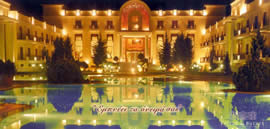
Τhe EPIRUS PALACE belong to the De Luxe category. It has 51 rooms and 2 Executive
Suites & and facilities of total surface 20.000 m2. The conference rooms can be used by 1000 people. Outside there is the big pool of 5002 and also the special pool for the children. The compound has a parking space for 450 cars. Besides that the hotel provides your transport from and to the airport.
http://www.epiruspalace.gr/
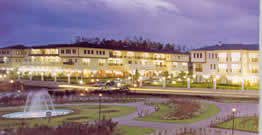
HOTEL DU LAC & CONGRESS CENTER It has been created with the prospective to combine the traditioanal hospitality with the luxuries witch the modern visitor demance.The 120 rooms and 9 suites are fully equipped with air-conditioning, satellite TV, mini bar, radio, digital central, luxurious marble-covered bathrooms and safety boxes in all the rooms.
A. Miaouli & Ikkou, 45221 Ιoannina, tel:. +30 26510- 59100, Fax:+30 26510-59200http://www.dulac.gr
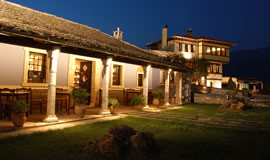
The complex Frontzou Politia (Hotel | Restaurant | Conference
Center | Cafeteria | Playground) is located on the hill of Agia Triada
near the center of the city of Ioannina, having great views to the
Lake Pamvotida. The hotel has 9 double rooms and 3
quad suites (one two-color), all different.
tel: +30 26510 21011
http://www.frontzupolitia.gr
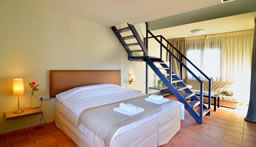
Ellopia Point is located in a location next to University in Pedini. It is an ideal place to stay with fourteen superb Rooms-Studios with many facilities. Leisure travelers and business travelers will find the ideal accommodation place. It consists of one-room apartments of 40 square meters each, luxurious, with nice decoration.Each apartment has: Fully equipped kitchen, Central air conditioning, Mini Βar, Double bed with orthopedic mattress, Folding sofa bed, Private balcony, Workbench,computer & internet connection, 26" TV, WiFi.
tel: +30 26510-94554
http://www.ellopiapoint.gr/en.html
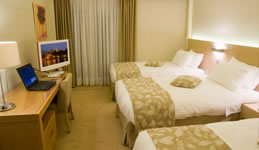
HOTEL OLYMPIC. The hotel OLYMPIC is located in the centre of the Ioannina city. It has 44 rooms, 8 suites and 2 sofit. Their luxurious and modern furnishing, their specialized design and the comfort of communication by telephone, music, mini bar and air-conditioning, comprise the basic characteristics of a comfortable and pleasant stay. More Facilities: 24h Internet Connection (Wireless). Parking: Enormous space for the keep of your vehicles. Without payment for the customers of hotel.
2, Melanidi 45332 Ioannina tel: :+30 26510-25147-25888 Fax:+3026510-22041
http://www.hotelolymp.gr
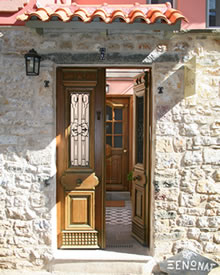
The traditional “Matsa” guesthouse is part of the historical centre of Ioannina, near the lake and the old castle, in a restored Jewish home of the 19th century. Rebuilt with care and respect to tradition, it accommodates four small apartments, each one unique and a beautiful courtyard.
Elegantly decorated, it opens its doors to guests with one and only purpose: to make them “feel like home”.
Traditional “Matsa” guesthouse, 5 Psalida str. & Josef Eliya, Ioannina, 45221.
Tel. +30 26510 22431, +30 6934 891752, +30 6936 440689, fax.+30 26510 22467,
www.xenonas-matsa.gr, info@xenonas-matsa.gr
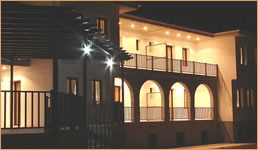
"HOTEL EXOHI offers three-star services and is built at the outskirts of the traditional dwellings of Perama in Ioannina prefecture.
The brand new HOTEL EXOHI launched in early 2008, is only 750 metres away from the cave of Perama. The rooms are double-bedded with option for an extra bed, all with private bath, TV, hair dryers, air conditioning, fireplace and terrace overlooking the lake Pamvotis, mount Mitsikeli or the hill of the famous cave of Perama.
Tel:+30 26510 81160
Fax: +30 26510 81061
http://www.hotel-exohi.gr
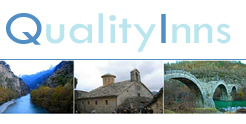
Quality Inns
Quality Inns is the first Traditional hotels chain at the region of Epirus Built according to Epirus architecture, harmoniously tied up with Epirus nature and tradition, our hotels wait for you to enjoy a pleasant stay and discover the beauties of the surroundings.
http://www.qualityinns.gr/
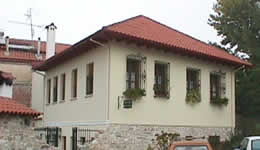
THE CASTLE. In Ioannina inside the old city, a warm-quite, family nest awaits for you. The hotel Castle has got 7 rooms, with 15 beds. Six of them are double-bed and one tree-bed. Only breakfast is being served, made of traditional products of Epirus. The service in the hotel is excellent and quarantee' s a pleasant stay, so you can get to know and visit Ioannina and the prefecture of Ioannina.
57, Andr. Palaiologou-45221 Ioannina. tel/ fax: +30 26510-22866 & 22780
http://www.ameliko.gr/
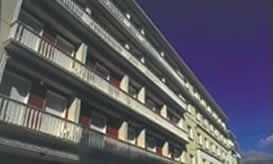
GRANT PALLADION HOTELThe hotel Palladion is located in the city center. It has got 121 rooms and 7 luxurious suites, all with the following equipment and comforts: private bathroom, air-conditioning, digital telephone, 25 channel TV, sound and heat-proof frames on door and windows. It also offers restaurant, bar, cafeteria, conference hall, parking, transport from and to the airport etc. Visits in the surrounding area can be organized.
1, Μ. Μpotsari 45444 Ioannina, tel: 26510-25856
Fax: +30 26510-74034 Mrs Christina Sourelihttp://www.palladionhotel.gr/index.html
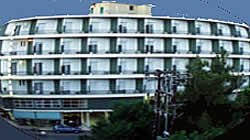
ALEXIOS Hotel Alexios is a proposal to relax, offering to its customers all the expected comforts and luxuries.By having 92 single-bed, double-bed and triple-bed rooms along with 4 suites. Having all our rooms renewed, plus offering central heating and air conditioning, music and color satellite television, sound-proof windows and safe box, refrigerator and mini bar, continuous hot water and hair-drier.
14, Karaiskaki & Poukevil 45444, Ioannina, tel: +30 26510-32030, 24003 Fax:+30 26510-32071
http://www.alexioshotel.gr
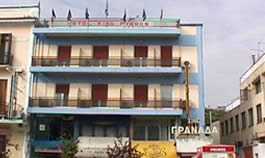
HOTEL KING PYRROS With the 30 years experience of constant operation we made the hospitality of Epirus synonym to our hotel. It is in the center of the city with view to the located park and the historic Clock, a small distance away from the lake, we offer: 23 rooms with air-conditioning, TV, digital telephone, sounded and heat-proof frames on door and windows. The service in the hotel is daily and the experienced staff is always available.
3, G. Gounari (Central square), 45444 Ioannina, tel.+30 26510-27652-29830, Fax: +30 26510-29980
http://www.kingpyrros.gr
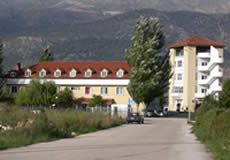
'KEKOP' In the area of KEKOP there are 30 rooms (65 beds) with private bathroom and excellent service from the staff. It provides restaurant and parking. Single 30 €,double 45 €, triple 54 €.
3 Axeronta Limnopoula Ioannina tel: +30 26510-20188, 32037.

'TOURIST ' hotel, fully renovaled, is situated in the center of Ioannina. We dispose 29 rooms with private bathroom, telephone , TV and A/C.
18, Kolleti str. Ioannina tel: +30 26510-25070,26443 Fax:+30 26510-20002
http://www.hoteltourist.gr/
Links
Eco-tourism in Epirus
http://www.ecotour-epirus.gr
Touristic police
http://www.uoi.gr/tourist_police/
Prefecture
http://www.nomioan.gr
Foundation Egnatia of Epirus
http://www.epcon.gr
Town Hall
http://www.ioannina.gr
University of Ioannina
http://www.uoi.gr
BIC Epirus
http://www.bicepirus.gr
Epirus S.A.
http://www.epirussa.gr
Caltural Center
http://www.ioanninacultcenter.gr
Museum of Greek history P.Vrelli
http://www.vrellis.org/gr/homegr.html
House rentals
http://enoikiazetai.uoi.gr
Greek national tourism organization
http://www.eot.gr
Airport
http://www.hcaa-eleng.gr/ioanina.htm
Region Of Epirus
http://www.roe.gr/index_en.htm

The Archaeological Museum of Ioannina exhibits finds from Epirus ranging from the Paleolithic period to Roman times. They include artefacts from the sacred area of what claimed to be the oldest-known oracle in ancient Greece in the Temple of Zeus at Dodona.
Byzantine finds can be seen at the 'little island' of Kyra Frosyni and monasteries with splendid frescoes, together with the legendary Ali Pasha's house - last refuge. The Byzantine museum at Ioannina situated in the medieval castle within the citadel, is also worth visiting. The tomb and the headquarters of Ali Pasha can also be found here. A walk along the lake shores and the castle walls, next to historical places and buildings conjures-up legends such as that of Kyra Frosyni. She was sentenced to drown in the lake after having caught the eye of Ali Pasha who desperately fell in love with her.
The University of Ioannina, major hospitals, the new Egnatia Motorway, the Nautical Club and the Centre of Nautical Sports, the Airport, the 'lake-planes', the expansion of the city, the construction of large-scale public works are evidence of the city's modern hub.
Town foundation
The town of Ioannina was founded by Emperor Justinian in the 6th centuary A.D. with the migration of the inhabitans of Evroia.The historian Procopius (6th century identifies the city as the "New Euroia" walled by the emperor Justinian. In 879 A.D. the Records of the Constantinople Synod are also signed by "Zacharias, Bishop of Ioanniki".Information about the town-castle are also provided by both the sigil of the emperor Vasilios B' Voulgaroktonos (1020 A.D.) and the "Alexias" written by Anna Comneni (1082 A.D.)During this period, as for many years to come, the city of Ioannina seems to be limited to the area encompasses within the fortress.According to the tradition, the town-castle receivedits name from its first constructor, Ioannis, or from the Monastery of St John the Baptist that stood in the Castle before the devastation of 1611.
Byzantine Period-Despotate of Epirus
In 1082,Ioannina is conquered by Bohemond, son of Robert Guiscard.The destruction of the city by the Norman infantry under the orders of William II, king of Sicily, is dated to 1185.
In 1204, Ioannina falls under the rule of Michael Angel Comnenus, who established the dynasty of the Despots of Epirus, with Arta as his capital.
Ever since then, Ioannina will follow the historical fate of the Despotate of Epirus which, encompassing an area going from Durrks to Lepanto (Nafpaktos in Greek) will be the outpost of Byzantine feudalism against the various raids of Franks,Venetians, Albanians and Serbs.
Ioannina grows and prospers under the rule of Michael A' Angel. Accordingto historical data, this period saw the establishment of official and scholars from Constantinople, after Frankish conquest of the city.Furthermore, around 1206, the walls of the fortress are repaired, the Scholi Philanthropinon is founded at the Spanou Monastery and the very old Monastery of Agios Nikolaos Stratigopoulou hosts the newly founded homonymous school.
The two monasteries will eventually become the center of the great art development the took place on the island later, especially during the 16th century.
In 1265, Ioannina is ceded by Nicephorus I Angel Comnenus to the Emperor if Nicaea, Michael Paleologus. After the latter' s death in 1282, Ioannina is once again part of the Despotate of Epirus, under Nicephorus the first Angel Comnenus. During this period, the seat of the religious head priest of the Despotate is transferred to Ioannina, the bishopric of witch becomes a metropolis, to counterbalance the establishment of the Catholic archbishopric at Nafpacto, when the city was ceded to Filippo Tarantino.
In 1296, with the death of Nicephorus the first Angel Comnenus, his widow Anna takes over the rule of Ioannina and Epirus, as guardian of her son Thomas I. During this regency, the Despotate gains Byzantine support against the pressures of the Andegaves. Thus, the imperial army is sent to Ioannina, under the leadership of John Lascaris, who subsequently holds it in tutelage, according to the will of Emperor Andronicus I.
In 1318, with the assassination of Thomas I, the last of the dynasty of the Despots of Epirus, Ioannina is contended by the Byzantine, the Andegaves and the Serbs. Finally it is sudjected to Byzantine rule, after the intervention of Ioannis Syrgiannis from Veratio, who convinced the population to submit to Andronicus II, so as to gain his favor. This capitulation is the cause of the two Chrysobulls (1319 and 1321) of Andronicus II, which are very revealing on the shistory of Ioannina and the evolution of feudal relations.
During the period of Byzantine rule, the power in Ioannina is held by Nicola Orsini, called John II Comnenus Angelodukas, his wife Anna Paleologue as guardian of her son Nicephorus II himself and finally Michael Angel. In 1399, the Byzantine rule of Ioannina is interrupted by the Serbs. Ioannina in 1367 acknowledges Thomas Prelubovich as its ruler. His rule is to be extremely tyrannical as he persecutes and taxed the popularion, exiles the metropolitan and confiscates church property, which, he allegedly distributes among his Serb followers. Against his dismal regime, it would seem that the Albanians of Ioannina ask fot the protection of the Albanian chieftains with strongholds in Epirus. This starts the Albanian raids against Ioannina which lead the Despot Thomas to repair and renovate the fortness of Ioannina in 1375. In 1384, the tyranny of Thomas Prebulovich comes to an end. The rule of the city is taken over by his widow, Maria Angela Paleologue. In 1386, against the threat of Albanian tribal chiefs, Buondelmonti is proclaimed despot of the city, bringing back the metropolis to its seat and implementing a wise administration of the population. However, Buondelmonti, under the pressure of continued Albanian raids and besieged by Spata, is obliged to ask for the protection of Sultan Murad 1st, which brings the first presence of Turkish armies in Ioannina. After the death of Buondelmonti in 1408-9, the power is taken over by Carlo I Tocco, duke of Cephalonia, who after losing the city to Bua Spata, re-conquers it in 1417/8 and maintains it until his death in 1429. Carlo I Tocco develops economically and intellectually the city and strengthens the Despotate. Carlo I Tocco is succeeded by Carlo II Tocco.
Post-Byzatine period,modern times
It is not by chance that Athanassios Tsakaloff, one of the founders of the Philike Hetairia, was from Ioannina seem to have been initiated into it. Irrefutable sources bear witness to the action of the Society's members from Ioannina both within the city and within the very court of Ali Pasha. The most important among them are Manthos Iconomou, Al. Noutsos, G. Tourtouris, I. Kolettis, I. Vilaras, Sp. Kolovos etc. From 1819 onwards, Ioannina in addition to being a center of new Hellenism, become the most important political center of national action and enlightenment. In 1822, Ioannina falls to Hoursit Pasha and Ali Pasha is killed in the Monastery of Agios Panteleimonas on the small island in the Pamvotida lake. While the siege of Ioannina is raging, the Greek Revolution starts in March 1821. In view of the large number of Turkish troops stationed in Epirus, the people of Ioannina and Epirus are unable to take an active role in the Revolution. Throughout the war, Ioannina, half-destroyed, remains nonetheless a base from which the Turkish army will strike against the insurrected Roumeli. With the end of the Revolution, Ioannina is not included in the liberated regions, which formed the new Greek nation. Ioannina becomes part of Greece on 21st February 1913. Finally, during WWI, Ioannina is temporarily occupied by Italian troops, between May and September 1917. From then onwards, the city follows the fate of the country.
From 1431 and until the times of Ali Pasha (1788), with the exception of the revolutionary movement of Dionysios (1611) called Slylosophos, no important event, military or otherwise action, is recorded at Ioannina. From 1788 and for 50 years, the city is marked by events of the utmost importance.In 1788, Ali Pasha of Tepelene becomes the ruler of Ioannina, establishing a tyrannical regime. For this entire period, the history of Ali is the history of Ioannina and Epirus as a whole. Ioannina, in spite of the harsh tyranny, keeps developing. During the rule of Ali Pasha, the urban transformation of the city takes place and Ioannina become the most important urban center of prerevolutionary Greece. In particular, Ali Pasha -having his own safety and wealth in mind, curbs the power and persecutes the timariot beys and strengthens the opportunities for the urban development of Ioannina. He repairs the fortness (1812-1815), opens roads towards Arta, Thassaly and Paramythia, subjugates Sterea Ellas and of the population of Ioannina. The majority seem to have embraced the values og the French Revolution. This ideological change is not alien to the clear and undeniable orientation of the population of Ioannina towards the idea of their own liberation and the preaching of Rhigas and of the Philike Hetairia (Society of Friends).
It is not by chance that Athanassios Tsakaloff, one of the founders of the Philike Hetairia, was from Ioannina seem to have been initiated into it. Irrefutable sources bear witness to the action of the Society's members from Ioannina both within the city and within the very court of Ali Pasha. The most important among them are Manthos Iconomou, Al. Noutsos, G. Tourtouris, I. Kolettis, I. Vilaras, Sp. Kolovos etc. From 1819 onwards, Ioannina in addition to being a center of new Hellenism, become the most important political center of national action and enlightenment. In 1822, Ioannina falls to Hoursit Pasha and Ali Pasha is killed in the Monastery of Agios Panteleimonas on the small island in the Pamvotida lake. While the siege of Ioannina is raging, the Greek Revolution starts in March 1821. In view of the large number of Turkish troops stationed in Epirus, the people of Ioannina and Epirus are unable to take an active role in the Revolution. Throughout the war, Ioannina, half-destroyed, remains nonetheless a base from which the Turkish army will strike against the insurrected Roumeli. With the end of the Revolution, Ioannina is not included in the liberated regions, which formed the new Greek nation. Ioannina becomes part of Greece on 21st February 1913. Finally, during WWI, Ioannina is temporarily occupied by Italian troops, between May and September 1917. From then onwards, the city follows the fate of the country.
Silversmith Craft
Silversmith craft in Ioannina has its roots in the depths of time, it has recorded an important growth from the times of Despot of Epirus onwards. The greatest flourishing was marked in the 18th and 19th century, when Ioannina was one of the most important intelectual, commercial and artistic centers in the Balkans.Drawing their inspiration from the works of the ancient Greek tradition and the unsurpassed Byzantine art, while expessing at the same time the values of Epirote sencitivity and aesthetics, they made their presence strongly felt in this important field of modern Greek silversmith activity.
The specificity of Ioannina art is mainly expressed by special manufacture techniques such as wrought ("sfyrilato"), chiseled ("fouskoto", "skalisto"), filigree ("syrmatero") and "savati", techniques which reached the peak of their expressive power in Ioannina.
The Ioannina jewels and utensils, avoiding the gaudy and showy forms of the East, as well as the excessively decorated, cold forms of the West, offer a warm human optical impression, rendered in a particular fine and elegant dimension.
The silversmith workshops presently operating at Ioannina continue the tradition, creating hand-made products of high artistic and aesthetic perfection, worth of their glorious past.
Dairy Products
The mountains of the wider Ioannina region, where animal husbandry is the most important activity, saw the development of a big daity tradition known to Greeks since the times of Homer.
The social contribution of this sector in the maintaining and development of sheep-and-goat raising in the region is very important. Using as raw material the fresh goat/sheep milk and respecting the cheese-making traditions, many small and medium sized units, as well as two of the major units in the sector, are active today in Ioannina offering consumers natural products of high standards. Fresh pasteurized milk, natural healthy yoghourt and fresh butter are part of the family of Ioannina dairy products.
The most dynamic product of the region is feta cheese and the cheeses with Protected Appellation of Origine like "kefalograviera", dry "mizithra", the Metsovone smoked cheese and "galotyri".
Other traditional products of the region are the graviera and kefalotyri cheese, the goat cheese, the "anthotyro" and many others. The unique taste and their exceptional quality place genuine Ioannina dairy products at the top of Greek and foreign consumers' preferences.
The flora rich in aromatic plants of the Prefecture of Ioannina, among the environmentally cleanest in Greece, give to the Ioannina dairy products their unique taste and aroma. The operation of the most important units, in accordance with international standards as to quality control, quarantees the exceptional quality of products.
The island
The island in the Pamvotida lake is an inseparable part of the history of Ioannina: it is related with the history and the death of Ali Pasha.
There are evidence already, from the Byzantine and Post-Byzantine period, of organized living on the island based on the eight monastery compounds.
The monastery Saint Nicholaos Philanthropinon (1292), Saint Nicholaos, also Diliou or Stratigopoulou, monastery Eleousis or Saint Nicholaos Goumaton (15th century), monastery of Metamorphosis Sotiros, compounds that are located on the north west side of the island and monastery Profiti Elia on the top of the hill, the monastery Kimiseos Theotokou and at last the monastery Saint Panteleimon. In the cells of this last monastery still exist the bulletholes that were fired against Ali Pasha when he tried to rescue himself from the siege by Hoursit Pasha.
In these monasteries and especially in the monastery of Saint Nicholaos Philanthropinon are being preserved wall paintings of splended art. It is remarkable that in the above monastery there are full body wallpaintings of seven ancient philosophers as Plato, Solon, Aristotelis, Plutarch, Thoukididis, Apollonius and Hilon.
Today the island is inhabited, which is seldom phenomenon worldwide, by 100 families who are all occupied with tourism and fishing.
It's connected with the city of Ioannina by small boats which cross every half hour in the summer and every hour in winter. On the island there are shops with folk art items and restaurants which serve fishes, eels, frog-legs e.t.c. It represents an important pole of touristic development of Ioannina.
The castle
The island in the Pamvotida lake is an inseparable part of the history of Ioannina: it is related with the history and the death of Ali Pasha.
There are evidence already, from the Byzantine and Post-Byzantine period, of organized living on the island based on the eight monastery compounds.
The monastery Saint Nicholaos Philanthropinon (1292), Saint Nicholaos, also Diliou or Stratigopoulou, monastery Eleousis or Saint Nicholaos Goumaton (15th century), monastery of Metamorphosis Sotiros, compounds that are located on the north west side of the island and monastery Profiti Elia on the top of the hill, the monastery Kimiseos Theotokou and at last the monastery Saint Panteleimon. In the cells of this last monastery still exist the bulletholes that were fired against Ali Pasha when he tried to rescue himself from the siege by Hoursit Pasha.
In these monasteries and especially in the monastery of Saint Nicholaos Philanthropinon are being preserved wall paintings of splended art. It is remarkable that in the above monastery there are full body wallpaintings of seven ancient philosophers as Platon, Solon, Aristotelis, Ploutarchos, Thoukididis, Apollonios and Hilon.
It is the only habitable island in a lake today worldwide. It's population is about 100 families who are all occupied with tourism and fishing.
It's connection with the city of Ioannina is being served by small boats which carry out routes every half hour at summer and every hour at winter time. On the island there are shops with folk art items and restaurants which serve fishes, eels, frog-legs e.t.c. It represents an important pole of touristic development of Ioannina.
The cave of Perama
One of the most important caves in the world is located just 4km away from the centre of Ioannina. The existance of the cave was already known since the start of the last century,in 1940 it was used as a shelter by the people during the Italian bombardisms.
In 1945 there was the first scientific mapping by the known couple of caveologists Anna and Ioannis Petrochilou who had explored other caves arround Greece.
It belongs to the horizontal caves with a length of about, 1km.The formings of stalagmites and stalactites, the natural richness and combination of colors create a landscabe of amazing natural beauty.
Transportation: City bus, route Ioannina-Perama with starting point next to the city-clock.
Visiting hours: 8:00am-19:00pm daily.
Tel : 26510-81521
Arrchaeological Museum
Arrchaeological Museum of Ioannina is in Litharitsia
Park, in the centre of the city. Finds from varius
ancient sites of Epirus such as Dodoni, Vitsa,
Acheronta of Necromanteion etc. are displayed in its rooms. Its exhibits also include stone and bone tools
of the Paleolithic era as well as tombstones, pieces of architecture, inscriptions and coins. In one hall, works by Greek artists of the 19th and 20th century are being housed temporarily.
25th Martiou Square. Tel:26510-33357, 31908,25490, Fax: 26510-71835
Byzantine Museum
The Byzantine Museum is in the Castle in the largest internal citadel which is known as the Its Kaly. It is housed on the ground floor of the former royal chamber which was built on Ali Pasha' s palace. Its collection includes finds (sacrificial objects, sculptures, icons, pottery, coins etc.) from various areas of Epirus which date from the Paleochristian era up until the 19th century. Also in the castle grounds, is the silverwork exhibition with ecclesiastical and decorative objects which is housed in the socalled treasury.
Ioannina Castle Tel: 26510-25989, 39580,
Fax:26510-39342
Wax works by Pavlos Vrellis
In the 14th km of national road of Ioannina-Athens, near Mpizani, is found of the museum of wax effigies of sculptor Pavlo Vrelli. The wax effigies of the museum, in natural size and included in a real- like representation of the environment of their age, revive forms of the newer history. There are three thematic units in the Museum: the Prorevolutionary period (the Concealed School, the foundation of the Friendly Company, the martyrdom of Dionysiou Skylosofou etc.), events of 1821 (the Thieves, the death of Ali Pasha e.t.c.) and themes from the World War II (the women of Pindos e.t.c.).
Museum of Wax Effigies Pavlos Vrelli. Tel. 26510-92128 open for the public 10:00p.m.-16:00m.m. for the wintry period and 09:30p.m.-17:00m.m. for the aestival period. http://www.vrellis.org/gr/homegr.html
Wax works by Athanasios Vrellis
The second museum of this type is found on the Karamanlis Street 15, by the castle walls. The creation of the representations has developed in the space of the exhibition which is functional since 1997. The total of representations is 14 and the dolls which participate are 70. The making craft is different from the others and the result reveals to the visitor the taste of Athanassios Vrelli for this unique type of museum in Greece.
Museum of Wax Effigies Athanassios Vrelli. Tel. 26510-22414, open for the public 9:00a.m - 3:00p.m. FREE ENTRY
Dodoni
One of the most important archaelogical areas of the prefecture is Dodoni, 22 km from Ioannina, south. The area is thought to be the cradle of the greek-spaiking tribes.
The theatre (with a capacity of 17.000 seats), the ancient Parliament (Voulephtirio), the Prythaneio, the Stadium, surround the ancient Shrine, considered as one of the most ancient oracles in the broader area of Greece. Its origin dates back to the depths of Prehistory. The Great Godess, the godess of fertility and euphoria, was initially worshiped there, to be later replaced by the Dodonian Zeus worship. The oracle was open-air at first, as people thought that Zeus lived in the roots of the sacred oaktree. Round the sacredtree there were tripods made of copper, making sounds used by the priests to tell the oracles.
Internet : http://www.ddodoni.gr
http://ioannina.uoi.gr/_en/info/index.html
Hotel

Τhe EPIRUS PALACE belong to the De Luxe category. It has 51 rooms and 2 Executive
Suites & and facilities of total surface 20.000 m2. The conference rooms can be used by 1000 people. Outside there is the big pool of 5002 and also the special pool for the children. The compound has a parking space for 450 cars. Besides that the hotel provides your transport from and to the airport.
http://www.epiruspalace.gr/

HOTEL DU LAC & CONGRESS CENTER It has been created with the prospective to combine the traditioanal hospitality with the luxuries witch the modern visitor demance.The 120 rooms and 9 suites are fully equipped with air-conditioning, satellite TV, mini bar, radio, digital central, luxurious marble-covered bathrooms and safety boxes in all the rooms.
A. Miaouli & Ikkou, 45221 Ιoannina, tel:. +30 26510- 59100, Fax:+30 26510-59200http://www.dulac.gr

The complex Frontzou Politia (Hotel | Restaurant | Conference
Center | Cafeteria | Playground) is located on the hill of Agia Triada
near the center of the city of Ioannina, having great views to the
Lake Pamvotida. The hotel has 9 double rooms and 3
quad suites (one two-color), all different.
tel: +30 26510 21011
http://www.frontzupolitia.gr

Ellopia Point is located in a location next to University in Pedini. It is an ideal place to stay with fourteen superb Rooms-Studios with many facilities. Leisure travelers and business travelers will find the ideal accommodation place. It consists of one-room apartments of 40 square meters each, luxurious, with nice decoration.Each apartment has: Fully equipped kitchen, Central air conditioning, Mini Βar, Double bed with orthopedic mattress, Folding sofa bed, Private balcony, Workbench,computer & internet connection, 26" TV, WiFi.
tel: +30 26510-94554
http://www.ellopiapoint.gr/en.html

HOTEL OLYMPIC. The hotel OLYMPIC is located in the centre of the Ioannina city. It has 44 rooms, 8 suites and 2 sofit. Their luxurious and modern furnishing, their specialized design and the comfort of communication by telephone, music, mini bar and air-conditioning, comprise the basic characteristics of a comfortable and pleasant stay. More Facilities: 24h Internet Connection (Wireless). Parking: Enormous space for the keep of your vehicles. Without payment for the customers of hotel.
2, Melanidi 45332 Ioannina tel: :+30 26510-25147-25888 Fax:+3026510-22041
http://www.hotelolymp.gr

The traditional “Matsa” guesthouse is part of the historical centre of Ioannina, near the lake and the old castle, in a restored Jewish home of the 19th century. Rebuilt with care and respect to tradition, it accommodates four small apartments, each one unique and a beautiful courtyard.
Elegantly decorated, it opens its doors to guests with one and only purpose: to make them “feel like home”.
Traditional “Matsa” guesthouse, 5 Psalida str. & Josef Eliya, Ioannina, 45221.
Tel. +30 26510 22431, +30 6934 891752, +30 6936 440689, fax.+30 26510 22467,
www.xenonas-matsa.gr, info@xenonas-matsa.gr

"HOTEL EXOHI offers three-star services and is built at the outskirts of the traditional dwellings of Perama in Ioannina prefecture.
The brand new HOTEL EXOHI launched in early 2008, is only 750 metres away from the cave of Perama. The rooms are double-bedded with option for an extra bed, all with private bath, TV, hair dryers, air conditioning, fireplace and terrace overlooking the lake Pamvotis, mount Mitsikeli or the hill of the famous cave of Perama.
Tel:+30 26510 81160
Fax: +30 26510 81061
http://www.hotel-exohi.gr

Quality Inns
Quality Inns is the first Traditional hotels chain at the region of Epirus Built according to Epirus architecture, harmoniously tied up with Epirus nature and tradition, our hotels wait for you to enjoy a pleasant stay and discover the beauties of the surroundings.
http://www.qualityinns.gr/

THE CASTLE. In Ioannina inside the old city, a warm-quite, family nest awaits for you. The hotel Castle has got 7 rooms, with 15 beds. Six of them are double-bed and one tree-bed. Only breakfast is being served, made of traditional products of Epirus. The service in the hotel is excellent and quarantee' s a pleasant stay, so you can get to know and visit Ioannina and the prefecture of Ioannina.
57, Andr. Palaiologou-45221 Ioannina. tel/ fax: +30 26510-22866 & 22780
http://www.ameliko.gr/

GRANT PALLADION HOTELThe hotel Palladion is located in the city center. It has got 121 rooms and 7 luxurious suites, all with the following equipment and comforts: private bathroom, air-conditioning, digital telephone, 25 channel TV, sound and heat-proof frames on door and windows. It also offers restaurant, bar, cafeteria, conference hall, parking, transport from and to the airport etc. Visits in the surrounding area can be organized.
1, Μ. Μpotsari 45444 Ioannina, tel: 26510-25856
Fax: +30 26510-74034 Mrs Christina Sourelihttp://www.palladionhotel.gr/index.html

ALEXIOS Hotel Alexios is a proposal to relax, offering to its customers all the expected comforts and luxuries.By having 92 single-bed, double-bed and triple-bed rooms along with 4 suites. Having all our rooms renewed, plus offering central heating and air conditioning, music and color satellite television, sound-proof windows and safe box, refrigerator and mini bar, continuous hot water and hair-drier.
14, Karaiskaki & Poukevil 45444, Ioannina, tel: +30 26510-32030, 24003 Fax:+30 26510-32071
http://www.alexioshotel.gr

HOTEL KING PYRROS With the 30 years experience of constant operation we made the hospitality of Epirus synonym to our hotel. It is in the center of the city with view to the located park and the historic Clock, a small distance away from the lake, we offer: 23 rooms with air-conditioning, TV, digital telephone, sounded and heat-proof frames on door and windows. The service in the hotel is daily and the experienced staff is always available.
3, G. Gounari (Central square), 45444 Ioannina, tel.+30 26510-27652-29830, Fax: +30 26510-29980
http://www.kingpyrros.gr

'KEKOP' In the area of KEKOP there are 30 rooms (65 beds) with private bathroom and excellent service from the staff. It provides restaurant and parking. Single 30 €,double 45 €, triple 54 €.
3 Axeronta Limnopoula Ioannina tel: +30 26510-20188, 32037.

'TOURIST ' hotel, fully renovaled, is situated in the center of Ioannina. We dispose 29 rooms with private bathroom, telephone , TV and A/C.
18, Kolleti str. Ioannina tel: +30 26510-25070,26443 Fax:+30 26510-20002
http://www.hoteltourist.gr/
Links
Eco-tourism in Epirus
http://www.ecotour-epirus.gr
Touristic police
http://www.uoi.gr/tourist_police/
Prefecture
http://www.nomioan.gr
Foundation Egnatia of Epirus
http://www.epcon.gr
Town Hall
http://www.ioannina.gr
University of Ioannina
http://www.uoi.gr
BIC Epirus
http://www.bicepirus.gr
Epirus S.A.
http://www.epirussa.gr
Caltural Center
http://www.ioanninacultcenter.gr
Museum of Greek history P.Vrelli
http://www.vrellis.org/gr/homegr.html
House rentals
http://enoikiazetai.uoi.gr
Greek national tourism organization
http://www.eot.gr
Airport
http://www.hcaa-eleng.gr/ioanina.htm
Region Of Epirus
http://www.roe.gr/index_en.htm

Δεν υπάρχουν σχόλια:
Δημοσίευση σχολίου